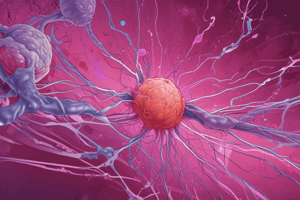Podcast
Questions and Answers
What is the characteristic age range for carcinoma?
What is the characteristic age range for carcinoma?
- Old age (above 45) (correct)
- Middle age (30-50)
- Young adults
- Children and teenagers
What is the typical spread of sarcoma?
What is the typical spread of sarcoma?
- Early by blood (correct)
- Late by blood
- Early by lymphatics
- Late by lymphatics
What is the characteristic consistency of sarcoma?
What is the characteristic consistency of sarcoma?
- Soft fleshy (correct)
- Hard and brittle
- Firm to hard
- Soft and squishy
What is the purpose of tumor markers in laboratory diagnosis of cancer?
What is the purpose of tumor markers in laboratory diagnosis of cancer?
What is the primary difference between carcinoma and sarcoma?
What is the primary difference between carcinoma and sarcoma?
What is the histological characteristic of carcinoma?
What is the histological characteristic of carcinoma?
What is the term for the study of neoplasms?
What is the term for the study of neoplasms?
What is the term for a spontaneous abnormal new growth that is causeless and aimless?
What is the term for a spontaneous abnormal new growth that is causeless and aimless?
Which of the following is a characteristic of neoplasia?
Which of the following is a characteristic of neoplasia?
What is the term for a malignant neoplasm?
What is the term for a malignant neoplasm?
According to the geographical distribution, which country has a higher incidence of stomach cancer?
According to the geographical distribution, which country has a higher incidence of stomach cancer?
What is the method of spread of malignant tumors through the bloodstream?
What is the method of spread of malignant tumors through the bloodstream?
What is the term used to describe the degree of differentiation of tumor cells in relation to the original tissue?
What is the term used to describe the degree of differentiation of tumor cells in relation to the original tissue?
What is a risk factor for cancer?
What is a risk factor for cancer?
What is the term used to describe the extent of spread of cancer?
What is the term used to describe the extent of spread of cancer?
What is the term for the lack of differentiation of tumor cells?
What is the term for the lack of differentiation of tumor cells?
What is an example of a complication of a benign tumor?
What is an example of a complication of a benign tumor?
What is the term for a developmental tumor-like malformation?
What is the term for a developmental tumor-like malformation?
What is the term used to describe a wasting syndrome in cancer patients?
What is the term used to describe a wasting syndrome in cancer patients?
What is an example of a cause of death in cancer patients?
What is an example of a cause of death in cancer patients?
What is the term for a benign tumor of smooth muscle tissue?
What is the term for a benign tumor of smooth muscle tissue?
Which of the following microscopic features is NOT a criterion of malignancy?
Which of the following microscopic features is NOT a criterion of malignancy?
What is the term for a benign tumor of cartilaginous tissue?
What is the term for a benign tumor of cartilaginous tissue?
Which of the following is a characteristic of malignant neoplasms?
Which of the following is a characteristic of malignant neoplasms?
What is the term for a benign tumor of blood vessels?
What is the term for a benign tumor of blood vessels?
Which of the following is a difference between benign and malignant neoplasms?
Which of the following is a difference between benign and malignant neoplasms?
What is the term for a benign tumor of nerve sheath tissue?
What is the term for a benign tumor of nerve sheath tissue?
Which of the following is a characteristic of benign neoplasms?
Which of the following is a characteristic of benign neoplasms?
Flashcards are hidden until you start studying
Study Notes
Routes of Metastasis
- Malignant tumors can spread through:
- Direct spread
- Lymphatic spread (e.g. carcinoma)
- Blood spread (hematogenous) (e.g. sarcoma)
Grading and Staging of Cancer
Grading
- Degree of differentiation of tumor cells in relation to original tissue
- Depends on aggressiveness of cells and number of mitosis
- Cancer classified as grades I to IV with increasing anaplasia
Staging
- Extent of spread of cancer
Complications of Benign Tumors
- Obstruction (e.g. larynx, CNS)
- Cosmetic problems
- May turn into malignant
- May be functioning (e.g. secreting hormones)
Causes of Death in Cancer
- Vital organs destruction (e.g. liver, brain)
- Vital organ obstruction (e.g. CNS, urinary tract)
- Malnutrition (e.g. GIT tumors affecting intake, digestion, and absorption of food)
- Cachexia (a wasting syndrome)
- Anemia (e.g. due to hemorrhage from ulcer)
- Secondary bacterial infection (e.g. toxemia, bronchopneumonia)
Comparison between Carcinoma and Sarcoma
- Carcinoma: malignant epithelial tumor, more common in old age, fungating, ulcerating or infiltrating, firm to hard consistency, less vascular, cells arranged in groups, spreads early by lymphatics, relatively better prognosis
- Sarcoma: malignant mesenchymal tumor, less common in young adults, bulky mass, soft fleshy consistency, highly vascular, cells arranged singly, spreads early by blood, worse prognosis
Laboratory Diagnosis of Cancer
- Gross appearance
- Histological examination
- Fine needle aspiration
- Cytological smears
- Immuno-histochemistry
- D.N.A. analysis
- Flow cytometry
- Tumor markers (e.g. alpha fetoprotein in liver carcinoma)
Definitions and Nomenclature
- Oncology: science of study of neoplasms
- Neoplasia: an spontaneous abnormal new growth which is causeless, aimless and without limitations
- Cancer: malignant neoplasm
- Differentiation: the extent to which tumor cells resemble normal cells
- Anaplasia: lack of differentiation
- Hamartoma: developmental tumor-like malformation
Etiology and Predisposing Factors
- Geographical (and race) distribution:
- USA: more common in males (lung, colon, and prostate) and females (lung, breast, and colon)
- Japan: more common in stomach cancer
- Age: usually more than 55 years, but some tumors can occur in children
- Hereditary factors: close relatives may get the same cancer
- Acquired lesions: can lead to cancer
- Chemicals: smoking, pollution, radiation, and parasites can increase cancer risk
- Physical: ionizing radiation, ultraviolet rays (UVR), and heat can increase cancer risk
- Hormones: estrogen and androgen can increase cancer risk
- Viruses: hepatitis B virus can increase cancer risk
- Nutritional: aflatoxin can increase cancer risk
Classifications
- According to tissue of origin:
- Epithelial tumors
- Connective tissue tumors
- Nervous tissue tumors
- According to behavior:
- Benign tumors
- Malignant tumors
Differences between Benign and Malignant Neoplasms
- Benign tumors: slowly growing, well differentiated, capsulated, less ulceration, hemorrhage, and necrosis, ↓mitoses and vascularity, no metastasis, not fatal
- Malignant tumors: rapidly growing, poorly differentiated, not capsulated, marked ulceration, hemorrhage, and necrosis, ↑mitoses and vascularity, metastasis, fatal
Microscopic Criteria of Malignancy
- Cells are of variable size and shape (pleomorphism)
- Cells are abnormally arranged (loss of polarity)
- Nuclei are:
- Large
- Hyperchromatic
- With prominent nucleoli
- With irregular nuclear membrane
- With many mitotic figures
Studying That Suits You
Use AI to generate personalized quizzes and flashcards to suit your learning preferences.




